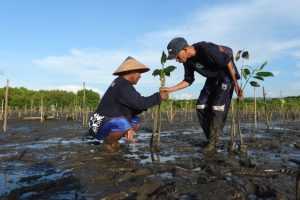Sumatran orangutan treats wounds with medicinal plants, raising questions about animal intelligence and the potential for collaboration in traditional medicine.
In a groundbreaking observation that rewrites our understanding of animal intelligence, a Sumatran orangutan named Rakus has been documented using a medicinal plant to treat a wound on its face. Researchers in Indonesia witnessed this remarkable display of self-care. The discovery suggested a level of cognitive sophistication in orangutans previously thought to be reserved for humans and a handful of other species.
Orangutan’s Deliberate Approach to Medicinal Plant
In the verdant rainforests of Aceh, Sumatra, researchers observed Rakus, a dominant male orangutan, sporting a fresh wound. Their attention soon shifted to his remarkable subsequent behaviour. Rakus deliberately approached a specific climbing vine – Akar Kuning (meaning “yellow root” in English) – a plant with a long history of use in Southeast Asian traditional medicine for its antibacterial, anti-inflammatory, and pain-relieving properties.
With a measured approach, Rakus plucked leaves from the vine, chewed them thoroughly, and then, in a fascinating display of tool use, applied the pulped material directly to his wound, seemingly aiming to promote healing. Remarkably, he even used the chewed plant matter as a makeshift bandage on some occasions.
Studies Indicate Health Benefits
A 2020 study by researchers at Universitas Gadjah Mada in Indonesia investigated the properties of yellow root (Arcangelisia flava). Three commonly used yellow root species (Arcangelisia flava, Coscinium fenestratum, and Fibraurea tinctoria) are known by various names, like Sirawan Kunyit (Java), and contain beneficial alkaloids and flavonoids. Scientific analysis reveals these plants contain compounds like berberine, which is believed to be responsible for the various health benefits attributed to yellow root.
According to the Badan Riset dan Inovasi Nasional (BRIN), Indonesia’s National Research and Innovation Agency, local communities in Indonesia have utilised yellow root for generations to address a wide range of health concerns. Some traditional medicinal applications of yellow root include:
- Hepatitis: Yellow root is believed to be effective in treating hepatitis B and C. (Note: More research is needed to confirm this claim.)
- Cancer: Studies have shown that berberine, a compound found in yellow root, can inhibit the growth of cancer cells. (Further research is ongoing.)
- Diarrhoea: Yellow root’s antidiarrheal properties may help alleviate diarrhoea caused by bacteria or viruses.
- Inflammation: The anti-inflammatory properties of yellow root may be beneficial for conditions like arthritis and rheumatism.
- Wounds: Topical application of yellow root is believed to promote wound healing.
First Documented Case of Animal Self-Medication
This meticulously documented behaviour by the research team marks a landmark discovery. It’s the first documented instance of an animal deliberately selecting and applying a plant with known medicinal properties to treat a wound. This finding has significant implications, particularly for understanding animal cognition, especially among primates closely related to humans, like orangutans.
Orangutan Intelligence: Beyond Tool Use
Orangutans, sharing roughly 97% of our DNA, are already known for their remarkable intelligence, which is evident in their tool-using skills, complex social structures, and problem-solving abilities. Rakus’s behavior adds another layer of complexity, suggesting a potential understanding of the medicinal properties of plants.
Discovery Resonates in Asia: Bridging Traditional and Modern Medicine
This discovery holds particular significance in Asia, a region with a long history of using herbal remedies. Traditional medicine practitioners have relied on the power of plants for generations. Consequently, Rakus’s actions highlight the potential for collaboration between these practitioners and modern scientists. Hence, combining traditional knowledge with scientific rigour might unlock the natural world’s secrets, leading to new and effective treatments for various ailments.
Implications Beyond Medicine: Re-evaluating Animal Intelligence
This discovery extends far beyond the realm of medicine. It compels us to re-evaluate our perception of animal intelligence. Self-medication, primarily associated with humans and a few other species, might be more widespread than previously thought. Further research is needed to determine if other animals, particularly primates, exhibit similar medicinal plant use.
Protecting a Wealth of Knowledge
Rakus’s story serves as a powerful starting point for further exploration. It underscores the urgent need for orangutan conservation efforts. These critically endangered creatures face a dire threat due to habitat loss driven by deforestation and the illegal pet trade. Protecting orangutans goes beyond safeguarding a species. It is about preserving a wealth of potential knowledge and understanding about the natural world.
With an estimated population of only around 14,600 individuals remaining in Sumatra, the future of these intelligent beings hangs in the balance. Rakus’s remarkable self-care not only sheds light on their cognitive abilities. It also serves as a poignant reminder of our responsibility to ensure their survival. Therefore, by protecting orangutans, we ensure the continued existence of a species with the potential to teach us much more about the world around us and ourselves.
The scientific community eagerly awaits further research to delve deeper into Rakus’s behaviour and its implications. In conclusion, this discovery has opened a new chapter in our understanding of animal cognition, blurring the lines between human and animal intelligence in a way that promises exciting scientific exploration and collaboration in the years to come.














